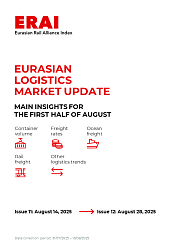Eurasian rail container freight traffic continued to grow steadily in 2021, outperforming target indicators. Over the past year, 693K TEUs travelled along the Eurasian railway route, which is 27% more than the figure for 2020.
In an environment of high rate volatility and carrying capacity constraints on alternative modes of transport, railways are demonstrating excellent service and high levels of reliability to the market. Rail transport plays a strategic role as a ‘land bridge’ between Europe and Asia, offering exactly what shippers need: regular shipments, minimal transit times and stable prices.
The diversification of freight delivery routes was another area of focus in 2021, with improvements to railway logistics through the ports and terminals of Kaliningrad Region at the centre of attention. By the end of 2021, traffic volumes on this route had increased by 188.8% to 133,300 TEUs. Transportation along this route highlights the advantages of a multimodal approach to transporting freight: first by rail and then by sea to neighbouring countries, using the common CIM/SMGS consignment note.
In 2021, rail once again increased its share of trade flows between China and the EU. The Eurasian railway route transported goods worth a total of USD 38.8 billion, accounting for 5.5% of total trade for the year between China and Europe and showing an increase of 23.3% on 2020. The freight base for the transported goods largely comprised mechanical equipment and appliances, electrical devices and communications equipment, vehicles and spare parts, various devices and medical equipment, furniture and lighting equipment, clothing, plastics and ferrous metal products.
At the same time, the past year was marked by the rapid development of other inland rail transportation routes. Based on container flow statistics, the Russian border crossing of Naushki, located on the border between Russia and Mongolia, was immediately behind the Kazakh border crossings with 71,1K TEUs (a +265% increase compared to the previous year). The Zabaikalsk border crossing between Russia and China accounted for 46K TEUs (+69%) and border crossings in Primorsky Territory saw 20,9K TEUs (+2,025%) in traffic.
The astonishing growth in volumes has been marked by a number of infrastructure constraints. The past year saw several failures even in well-established rail transit settings, primarily due to restrictions on segments adjacent to the Eurasian route. Nevertheless, rail has generally managed to cope with the higher volumes, even taking into account the slight increase in average travel times, to as much as seven days on the 1,520 mm track gauge infrastructure.
The most problematic area for balancing the flow of goods is transportation from Europe to China. Nevertheless, the share of loaded containers in Europe—China traffic in 2021 was 88.1%, exceeding the 2020 figure (82.7%). This is well above the 2018 figure of 59.1%. This trend indicates the effectiveness of work done to attract European shippers and improve the efficiency of the route. Since 2019, there has been a tendency for an almost total dominance of loaded containers in China—Europe traffic. In 2018, the share of loaded containers in freight flows from China to Europe was 75.2%. Over the past three years it has not fallen below 98.5%, and last year reached 99.4%.
The current state of affairs prioritizes the stress resistance of transportation, and this has been the main focus of stakeholders over the past year. In August, the heads of the Belarusian, Kazakh and Russian railways signed a memorandum on the development of Eurasian rail traffic in the presence of the prime ministers of the respective countries, confirming the commitment of the states to the consistent and comprehensive development of Eurasia’s railway infrastructure.
The past year once again underlined the inherent advantage of rail freight transportation — its environmental performance — especially in the context of the growing decarbonization agenda and the EU and China’s green policies. The СО2 Counter on the ERAI website clearly demonstrates this advantage. Documenting emissions reductions achieved through the use of rail transportation is a priority at present.
Rail retained its key advantages of reliability, speed, and transportation costs in the difficult operating conditions of 2021 and against the backdrop of ever-increasing infrastructure load and international political turbulence. At the same time, the Eurasian railway route has shown its ability to operate in the face of growing uncertainty and pressure on infrastructure, operators and service providers alike.




